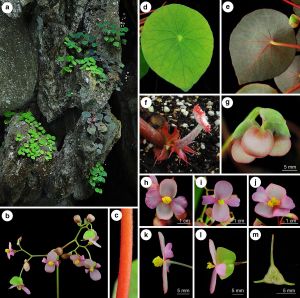Begonia taraw: Difference between revisions
(Created page with "__NOTOC__ <div class="page-container"> <div class="infobox-container"> <div class="infobox"> <div class="infoboximg"> thumb|center| B. taraw </div> {{Infoboxsp | species = taraw | region = South East Asia | country = Philippines | year_published = 2015 | Date_of_Origin = | plant_type = rhizomatous | section = Baryandra | Chr_2n = 28 }} <...") |
No edit summary |
||
| Line 4: | Line 4: | ||
<div class="infobox"> | <div class="infobox"> | ||
<div class="infoboximg"> | <div class="infoboximg"> | ||
[[File: | [[File:Begoniataraw.jpg|thumb|center| B. taraw]] | ||
</div> | </div> | ||
{{Infoboxsp | {{Infoboxsp | ||
| Line 53: | Line 53: | ||
=== Photos === | === Photos === | ||
=== External Links === | === External Links === | ||
Revision as of 13:40, 20 October 2023
Species Information
Classification and Distribution
Begonia taraw is a lithophytic rhizomatous herb endemic to Palawan, Philippines. It is known from the type locality and a further field observation from Lions Cave.
Habitat
The species grows on vertical limestone cliffs semi-shaded by broadleaf forest at the entrance of the Puerto Princesa underground river.
Characteristics
Begonia taraw is a lithophytic rhizomatous herb that reaches a height of 20–35 cm. It has glabrous stems with short internodes on the rhizome. The leaves are peltate, with erect petioles. The upper surface of the leaf lamina varies in color from pale to very dark matte green, while the lower surface is sparsely lanate on the veins and lamina.
Flower Details
The inflorescence is erect and can reach a height of 40–58 cm. It consists of bisexual flowers, and male and female flowers open at the same time as the inflorescence matures. Male flowers have four uniformly white or pink tepals, while female flowers have fleshy hair-like bracteoles and a 3-locular ovary.
Etymology
The species is named after the local word "taraw," which means karst limestone in Tagbanua language.
Comparison to Similar Species
Please fill in details
References
Please fill in links to references used in this page.
Photos
External Links
Links to pages related to this species
